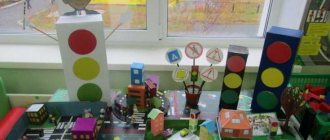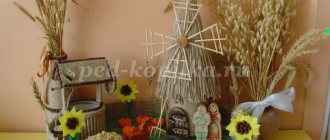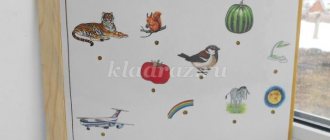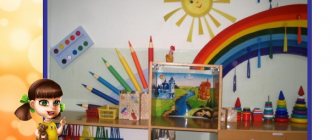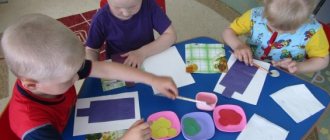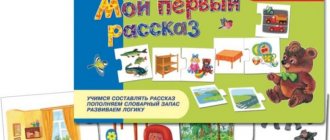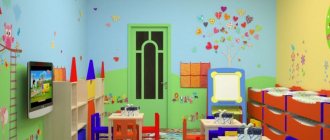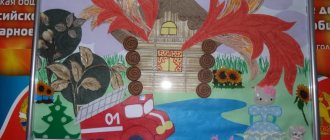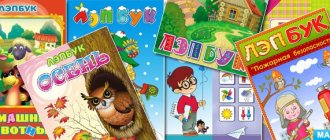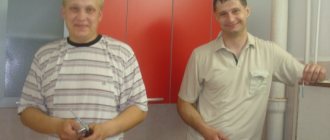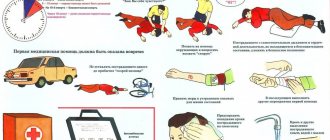Manual "Fabric Collection"
Lyudmila Verchenko
Manual “Fabric Collection”
Dear Colleagues! I would like to introduce you to my “fabric collection”!
I thought and pondered for a very long time how to make it so that the children could see what it is made of and what they sew from it. Of course there is a very large amount of fabrics. And it’s simply not possible to collect all the fabrics. I of course started with the basic fabrics that kids need to know. And I started with natural ones, which are made from natural raw materials. These are cotton, linen, wool and silk. I selected pictures and printed them out.
Goal : To introduce children to different types of fabrics. Teach to distinguish by touch and by external signs. Enrich children's vocabulary.
Of course, I will continue to expand the collection with other fabrics, since I haven’t collected everything yet. Children can touch all fabrics. They can be easily retrieved from files.
Let's start watching!
We will continue to replenish and other types of fabrics will appear.
Thank you for your attention!
Collection “Dolls in folk costumes” I bring to your attention a collection of dolls in folk costumes. All dolls are made of porcelain, handmade. The costumes for them are made of high quality.
Abstract of the GCD “Clothing by season: winter, summer, demi-season. Types of fabrics" (senior preschool age) Educational goals: To consolidate children's knowledge about the general concept of "clothing". Introduce children to the classification of clothing by season - winter,.
Card index of experiments and experiments in the senior group “Identification of the properties of natural fabrics” state budgetary educational institution secondary school named after the hero of the Soviet Union Matvey Nikiforovich.
Family collection of children's books “How to be able to read well!” How wonderful it is to pick up a book that your mother saved! We got this opportunity thanks to... Collection of fabrics. A manual on the tactile development of children, collection of fabrics. To develop the tactile sense, I use a collection of fabrics. Such a collection should be present in a developing environment.
Abstract OOD Cognitive development. Conversation about the work of garment industry workers. Familiarization with the properties of fabrics. Program objectives: To clarify knowledge about the work of those who sew clothes, to help understand the significance of this profession. Activate knowledge about different.
Photo essay “My Magnetic Collection” Our family has long had a tradition of bringing magnets and plates as gifts from various trips. In every country there are souvenirs. My “sweet” collection The school year is coming to an end... You can relax a little! I really wanted to tell the MAAM members about my hobby. “Sweeten” yours.
Open lesson on cognitive development in the middle group “Journey into the past of fabrics” Open lesson on cognitive development “Journey into the past of fabrics” Purpose: 1. To introduce children to the methods of producing fabrics.
Thematic week “Soil”. Visual and didactic aid “Collection of stones” I continue to publish about our activities during the thematic week “Soil”. We introduce children to soil and the elements that go into it.
DIY themed albums for kindergarten
Thematic albums for the development of creative activity of older preschoolers.
This material will be useful to teachers of preschool institutions, parents (legal representatives) of children of preschool and primary school age.
I present my experience in creating and working with thematic albums aimed at developing creative activity and children's individualization in older preschoolers. Tasks: Create expressive images through shape, proportions, characteristic poses, gestures, using various materials. Create new color tones. Mastering new ways of working with watercolors. To improve children's skills in sculpting objects that are more complex in shape and structure using combined methods, using stacks, stamps, and materials to strengthen elongated, elongated forms. Expand and deepen the understanding of different types and genres of fine art: graphics, painting, the ability to see their features and distinctive features. Reflect in drawing and modeling the unique architecture style and purpose of the structure and buildings. Create sculptural compositions from several objects. 1. Thematic album “Drawing”
This album contains algorithms for drawing subject pictures from simple to more complex. There are interesting algorithms for boys and girls to perform. The frequency of changing visibility depends on comprehensive thematic planning.
The album contains color mixing algorithms to obtain the desired colors and shades.
2. Thematic album “Modeling”
This album presents algorithms for sculpting objects from simple to more complex.
3. Thematic album “Do it yourself”
In the album on the first page there are rules for using scissors.
The album presents algorithms for performing creative works from paper, made using various techniques.
There are mini-albums on applique.
4. Thematic album “Origami”
Algorithms of work from simple to more complex are presented.
5. Thematic album “Crafts from natural materials”
The album contains both the crafts themselves and algorithms for making appliqué and crafts from natural materials.
6. Thematic album “Beads and bracelets” 7. Thematic album “Options and algorithm for depicting fireworks” 8. Thematic album: “Algorithms for performing creative work on the theme “Space”
The album contains algorithms for modeling, drawing, appliqué, origami, design, and manual labor on the theme “space.” As well as a children's magazine on this topic.
9. Thematic album "Architecture"
For this manual, I have developed a methodological guide for working with it. The album presents different options for architectural structures. Children also have at their disposal various author's books and manuals to explore children's creative initiative.
We recommend watching:
Synopsis of a comprehensive educational program for the development of fine motor skills and coordination of finger movements in the senior group Synopsis of a lesson on the surrounding world in the senior group with a presentation Synopsis of the organization of household work "Book Workshop" in the senior group Synopsis of direct educational activities on the development of speech and the surrounding world ( older
Similar articles:
Nurturing cognitive interests in children of senior preschool age
Identification of cognitive interests in preschool children
Formation of cognitive interest in mathematics among older preschoolers
Cultivating cognitive interest in nature in children of senior preschool age
Cultivating cognitive interest in book graphics in children of senior preschool age
Visual aid “Types of fabrics”
Domnina Galina
Visual aid “Types of fabrics”
Hello, I would like to suggest making a manual “Types of fabric ”
for the topic
“Clothing”
This colorful, bright manual will allow the child not only to visually see the variety of fabrics , but also to touch it. fabrics in rich colors, those that are found in everyday life.
Prepare various rags, but I focused more on cotton ones.
A4 photo paper
Laminated A4 sheets
Tissue flaps
1. We take different types of fabrics .
2. We choose from them according to classification. Vegetable animal origin and synthetic artificial fabrics .
3. We make clothing blanks on paper. You can fantasize.
4. I advise you to prepare A4 sheets with a background and laminate them. This is necessary so that the sheets do not fray, and children can touch the fabric for softness , hardness, smoothness, thickness.
5. Take scraps of fabric and lay paper clothing samples on top.
I prepared samples of plant tissues
6. Take woolen fabrics . We lay out the paper blanks in the same way. Cut it out and paste it into an album.
In the same way, we take silk fabrics , cut out the blanks and glue them.
samples of artificial and synthetic fabrics according to the same pattern.
fabric samples , some may be repeated, but the colors should be different.
It was not easy to produce this manual , but it turned out to be colorful, interesting, and useful not only for children, but also for teachers.
Didactic visual aid lapbook “The ABC of Road Traffic” for middle-aged and older children Relevance: -The relevance of this manual is due to statistics indicating an increase in children's road traffic injuries. Didactic visual aid “Autumn mushrooms from foam sponges and mesh” There are a lot of mushroom crafts that you can make at home. Just use your imagination and stock up on what.Summary of a lesson on cognitive and research activities of children of the preparatory group “The World of Fabrics” Goal: Development of creative research activity of preschoolers in the process of children's experimentation using the example of fabrics. Tasks: 1.
Master class “Visual aid “Fire mini-shield” Good day, colleagues! The idea of creating a visual aid arose suddenly. Reviewing fire safety information. Visual educational aid “Types of transport” in a middle-aged group Purpose: to arouse children’s interest in the objects of their immediate environment and to develop knowledge about types of transport and its purpose (ground, air, etc. Visual aid for children “Where vitamins live” Purpose: to introduce children to the concept of “vitamins” and the products in which they are found. Objectives: to summarize and systematize children’s knowledge. Visual aid “Health Cube” Authors of the manual: Inga Aleksandrovna Shcherbakova, Natalya Vadimovna Govorova. Good afternoon, dear colleagues! It’s no secret that vitamins. Do-it-yourself visual aid in the form of a mobile folder for Cosmonautics Day. And so what is a mobile folder? A mobile folder is a beautifully designed material, decorated with illustrations, on a specific topic. Visual aid mobile "Planets of the Solar System" for older children preschool age with your own hands Good day, colleagues! I bring to your attention the manual “Planets of the Solar System”, which you can make yourself. For work. Visual aid “Rook Bird” You need: 1. PVA glue, “moment” glue 2. cotton wool 3. threads 4. scissors 5. gouache paint, color - black 6. black and gray felt 7. beads for the eyes.
Project “For children about fabrics”
Project “In the wonderful world of fabric”
Introducing children to everything that society does is the most important task of all generations.
The main issue of the project is creating conditions for the development of preschool children through familiarization with the properties and qualities of fabric. The project clearly traces the relationship between the cognitive development of a preschooler through cognitive and research activities. The project contributes to the development of pupils’ horizons, the formation of cognitive activity, and respectful attitude towards working people.
Objective of the project:
development of cognitive abilities and cognitive activity of middle-aged children, through familiarization with the properties of fabric.
Formulation of the problem:
The choice of the project topic was not accidental. One day, two dolls “came” to the children’s group. One doll was wearing a dress made of leaves, and the other was wearing a dress made of animal skin. This information was from the history of the origin of the clothes. Getting acquainted with the types of modern clothes and what they are made of, it turned out that many of the children do not know what fabric is.
This is how the idea of the project arose and a great desire to pass on to every child not only knowledge about fabric, but also to bring them to the understanding that fabric is very necessary and useful for humans, as well as to introduce children to the purpose of fabric.
Project type:
- According to the dominant activity in the project: research, educational.
- Content: pedagogical.
- According to the composition of participants: group.
- By duration: short-term, 10 days.
Location:
Children's educational institution No. 104, group No. 3, as well as a mini-laboratory and a wardrobe maid's office.
Objectives of project activities:
- “Cognitive development”: help children learn about the properties and qualities of fabric; develop cognitive interest in research activities, the desire to learn new things; develop research skills.
- “Speech development”: develop connected speech, activate and enrich vocabulary, and also develop children’s play activities; ability to work in a team, participate in joint experimental activities.
- “Social and communicative development”: to cultivate a value attitude towards the work of adults, to introduce the profession of a seamstress, and safety precautions when working with scissors and a needle.
Educational:
develop memory, thinking, logic (draw conclusions), attention (ability to see the main thing).
Project stages:
- Organizational and preparatory.
- Basic.
- Final.
Project participants:
teacher Pishchugina Lilia Vladimirovna, children of the middle group, parents of children, housekeeper Khoroshilova Marina Yuryevna.
Expected results:
Enriching children with knowledge about the properties and qualities of fabric will help them identify objects such as function (method of use) and purpose (ability to satisfy needs).
Relevance:
The surrounding reality appears before the child in all its diversity: nature, man, the man-made world, etc. Introducing children to everything that society lives is a task that humanity has been solving since the need to pass on the experience of the previous one to each subsequent generation began to be realized.
The objective world has a great influence on the emerging needs of a little person and serves as a kind of support for him in communicating with other people. Through the object, the child learns that the world has different properties and qualities. He masters ways of acting with objects, and this helps him acquire “power” over the world in which he lives. The subject introduces the child into the world of adults, “informs” him about this world, enriches the content of social experience and influences all-round development.
The formation of attitudes towards the objective world is reflected in the studies of R.I. Zhukovskaya, R.I. Zinchenko, I.I. Rozanova, who studied the process of instilling a caring attitude towards the results of the work of adults and developing in children a feeling of gratitude to an adult for caring about them. The objective world in their works is seen as a means of instilling such moral qualities as thrift, care, accuracy, hard work, the habit that every thing has its place, and the awareness that adults work hard to create things, so the results of their labor must be preserved.
Objects are characterized by characteristics that the child perceives through sensory means, i.e. visually, tactilely, tactilely and through mental operations. This is what ensures the development of his personality.
According to O.V. Dybina, children’s cognitive activity is realized in activities. It is search activity that is capable of mobilizing the strength of preschoolers in understanding reality, independently discovering its connections, relationships, patterns, and in transforming experience.
Therefore, children 4-5 years old need to be introduced to the objective world in the process of acting with objects, i.e. allow children to feel, stroke, break, tear, bend, squeeze, throw, lift, etc.
Project implementation.
- Stage
During the organizational and preparatory stage, we, together with the parents, carried out work to collect an album on the topic: “The World of Fabrics,” which includes samples of material. As well as creating a folder “About Fabric”, which includes information about each fabric sample (see the album “World of Fabrics”)
- Stage
During the main stage, we carried out educational and research activities. In the laboratory of our educational institution, we conducted experiments to familiarize ourselves with the properties and quality of fabrics. We also visited the office of the wardrobe maid, Marina Yurievna Khoroshilova, in order to get acquainted with the profession of a seamstress.
- Stage
At the final stage, we conducted a lesson to consolidate the knowledge gained during the implementation of the project.
Chintz
Made from natural cotton using plain weave. Previously, the Surat species was often used for production. It has a medium thickness and twist.
Standard thickness is from 80 to 100 g/m. Plain weave is the simplest. One warp thread corresponds to one weft thread. The manufacturing process is as follows:
- Procurement of raw materials
. First you need to collect raw cotton. It is cleaned and prepared for carding.
- Carding comb
includes: loosening, mixing, scuffing and scraping. Debris is removed from the raw material, it is combed out and bleached.
- Once the fibers have become clean and uniform, they dyed or woven into fiber
. Typically, “surface” dyeing is used for chintz, that is, the design is printed on the finished fabric, rather than the fibers being dyed
Plain weave is also considered the most durable. The weft thread overlaps every other warp thread. It refers to the main weaves. As a result of its modification, patterns are obtained. You can easily see the even and odd warp threads on the fabric. This fabric is usually produced on machines with 2 and 4 healds.
Chintz is dyed using the printed method. This method originated in India. Initially it was “manual”, so the price was far from budget. In order to apply the image, blank boards were made. They were usually made of wood. The required pattern was stamped on them. The areas that were to be painted were filled with paint. Then fabric was placed on the boards, and the surface was tapped with hammers.
Currently, the printing method has moved from the category of manual labor to machine labor, but the principle remains the same. Moreover, the first steps in this direction were taken at the end of the 18th century in Switzerland.
Application area
Chintz is an ideal material for the summer heat. It's light. The fabric allows air to pass through well and prevents the body from overheating. The natural material is pleasant to the body and does not irritate the skin at all.
Used for sewing the following products:
- Summer women's and children's clothing (sundresses, dresses, shirts);
- Homewear and sleep options (pajamas, nightgowns, dressing gowns);
- Bed linen and decorative pillows;
- Tablecloths, curtains, potholders.
This is an ideal material if you decide to decorate your kitchen in Provence style. It is gentle, light and unobtrusive. At the same time, he is very cute and “homey”. If you want to make the room cozy, then pay attention to sofa cushions, tablecloths or chair covers made of chintz. The pattern with a small flower or stripe is especially charming.
Advantages
Let's talk about the advantages:
- Natural environmentally friendly material;
- Bright colors and interesting design;
- Safe for children;
- It does not require special care;
- Absorbs moisture well and allows air to pass through;
- The body under chintz products “breathes”;
- Affordable price;
- Wide range of applications;
- Easy to sew.
Flaws
But it also has significant disadvantages:
- May shrink;
- If it is poorly made, it quickly breaks and fades;
- Crease level is above average.
Modern chintz, thanks to new processing technologies, cannot be compared with the material that was 20 years ago. Other dyes are used, which allows the fabric to fade less. New developments in weaving are helping to make the material less easy to tear. All this definitely smooths out the existing shortcomings.
Chintz is not only an opportunity to return to the good old Soviet times. This is a material that, despite its low cost, has many pleasant characteristics. It is environmentally friendly and lightweight. The material allows you to create a delicate image of your home and bring a piece of French into it
Linen
Linen is a fabric of plant origin that has the following properties: linen products absorb moisture well and dry quickly. This is the most breathable fabric. Linen clothes can be worn both in winter and in summer: in hot weather, linen material “cools”, and in cool weather it warms. In addition, the fabric is easy to wash, dries quickly, is very hygienic and durable. Linen has very high strength, but also wrinkles easily. Has low elasticity.
It is not recommended to use acidic solutions on fabric; they destroy it. Dyed linen should be washed at a water temperature of no more than 60 degrees.
It is not recommended to dry linen near heating devices or in the sun. Linen should be ironed with a hot iron from the wrong side of the fabric, using moistened gauze. Some linen items are worn slightly wrinkled to emphasize the delicacy of the weave.
Cotton
Cotton is a natural material that is extracted from cotton bolls. Chintz, calico, satin, thin cambric and chiffon, denim - these are just some of the materials that belong to cotton fabrics. Cotton products have good hygienic properties, easily absorb moisture, and allow air to pass through. Cotton is comfortable and pleasant to wear, soft and has mechanical density, relatively high heat resistance. The fabric is characterized by easy creasing. Comparing it with other plant fibers, it can be noted that the warming effect of cotton is higher than that of flax. Cotton is stronger than wool, although less durable than linen or silk. Cotton products shrink when washed and take a long time to dry; they cannot be dried in a washing machine, with heating devices or in the sun.
White cotton is washed at temperatures up to 95o, colored or dark - up to 40o. Cotton clothes should be ironed using damp gauze.
Wool
Wool is the softest and warmest type of fabric, similar in structure to human hair. Modern woolen fabrics are divided into two categories: wool (90% wool thread) and wool blend (20-90% wool + lavsan, nylon or viscose). Woolen fabrics of the second category are less soft, warm, but more wear-resistant. By origin, wool can be: camel, sheep, rabbit, dog, etc. Wool has the highest hygroscopicity among fabrics (absorbs up to 40% of moisture, while remaining dry to the touch). Very delicate and soft fabric. Woolen fabrics get dirty a little and hardly wrinkle.
It is recommended to wash wool products by hand using special wool detergents. Wool shrinks a lot when washed. The fabric should not be washed in powders containing bleach, it should not be rubbed or wrung out vigorously. The wool is dried in a horizontal position on a terry towel. Wool should be washed and rinsed in water at the same temperature. The recommended temperature for washing wool is no more than 50? C, and in some cases not higher than 30? C. It is better to iron woolen items damp through damp cotton cloth.
Silk
Silk is obtained from the cocoon of the silkworm, in an absolutely natural way. The fabric is soft and pleasant to the touch, perfect for hot weather. It quickly absorbs moisture and dries quickly. Silk fabrics are very durable and light. There are practically no pellets formed on silk fabric. Twisted silk is considered the highest quality; it is obtained from long threads from the middle of the cocoon. Silk fabric requires hand washing at 30°C with soft washing powder, with a light spin. It is best to dry silk items in the shade. Iron silk items from the inside out, slightly damp, but the product cannot be additionally moistened, as stains will remain. When washing, any silk sheds a lot, so it needs to be rinsed first in warm and then in cold water. To restore color saturation, it is recommended to add vinegar while rinsing in cold water.
Denim - interesting facts
What is denim
Denim is a thick cotton fabric with a twill weave. Twill weave forms clear diagonal stripes on the fabric - a rib.
Most denim has a right hand weave twill. In it, the hem goes from bottom left to top to right. These fabrics are denser and more durable, with an uneven surface. During use, they are wiped off unevenly and become more contrasting.
There are denim fabrics with a left-hand weave, in which the rib is directed in the other direction - from bottom right to top left. These fabrics have a smoother and smoother surface.
And there are denim fabrics with broken twill, in which the weave forms a herringbone pattern on the surface. These fabrics are softer and have an original appearance.
Well, modern designers offer a variety of new variations of weaves that form various designs and patterns.
Denim composition
Denim fabric is cotton. That is, they get it from cotton. And the quality of the fabric largely depends on the type of cotton used. Most fabrics use short-staple Indian and Asian cotton due to its low cost.
In the last century, stretch denim appeared thanks to the addition of the elastic polyurethane thread elastane. Stretch fabrics contain 2–7% elastane, are elastic, resilient, and allow you to sew narrow, tight-fitting models.
Modern manufacturers are constantly experimenting and improving the production of denim fabrics. They combine two different layers into one: denim and knitwear, raincoat, wool, silk, etc. materials. And they obtain dense, elastic, flexible fabrics with remarkable heat-protective properties.
Preview:
GBDOU Kindergarten No. 74
Krasnogvardeisky district of St. Petersburg
“Different fabrics are needed, different fabrics are important”
(for senior preschool age)
“Clothing is not just a rag that covers the body, it is a reflection of a person. Therefore, it says more about a person than he does himself.”
1. Relevance: Children enter this world thinking that everything around them has always been there. And few ask the question: “Where did this come from? What is it for? What qualities does the object have? Etc." And how can we make sure that children awaken an interest in what they come into contact with every day?
On the topic: methodological developments, presentations and notes
A lesson to familiarize preschoolers with the digestive system and the components of a healthy diet. Arouse cognitive interest in knowledge about the structure of their body. Give an idea of the benefits of vitamins.
Entertainment for middle school children and parents on February 23rd.
Abstract of children's cognitive development. Introduces children to a variety of food products.
Learn to match nouns to verbs according to their meaning. Develop observation skills, recognize a person’s profession by their costume. Strengthen the ability to unite etc.
Holiday script dedicated to Mother's Day.
Continue to strengthen children's knowledge about professions. Clarify children's knowledge that women can work where men traditionally work (cosmonauts, pilots, drivers, etc.). Wake up.
Children in the older group study different types of fabrics in various activities throughout the day.
Family project “Fabric Collection”
| The date of the: from March 14 to March 27, 2021 (two weeks). Project participants: family of Polina Okshina, 5 years old. View: short-term, information and research. Problem: Polina loves to dress up, but does not know what fabrics clothes are made from. Target : develop curiosity, cognitive activity, interest in the man-made world, in particular in fabrics. Expand and generalize knowledge about tissues, understanding the significance of tissues in human life. Tasks: 1. Systematize ideas about the properties of fabrics. 2. Develop skills in conducting simple experiments. 3. Develop the ability to establish elementary connections and dependencies based on the objects under study (tissues). 4. Exercise the ability to build a business dialogue in the process of joint activities. 5. Promote the active use of detailed narrative statements in speech. 6. To develop the ability to reflect in speech ideas about the diversity of properties and qualities of fabrics. 7. Reinforce the use of the names of survey actions in speech. 8. To develop the ability to establish positive relationships in the process of joint search activities. 9. Develop fine motor skills of the hands. 10. Create conditions for the manifestation of creativity and imagination when creating appliqué from colored scraps. 11. Develop the ability to create an applique image from the proposed fabrics. Problem tasks : 1) Forecast task: Polina's statement: “What is good and what is bad about different types of fabric?” Bad: it tears, wrinkles, fades, it’s not the right time to use the fabric. Good: protects the body from the effects of precipitation, warms, decorates our body. 2) Problem with reliable conditions : Invite Polina to decide and express her assumptions about the following situations: - Why will it be cold in a chintz fur coat in winter, and hot in a drape dress in summer? — What if you wear a nylon raincoat in the rain? — If the firefighter’s overalls were not made from special fire-resistant fabric, would the firefighter be able to help people in trouble? Tell us about special clothing (firefighter, doctor, cook, miner, etc.). Equipment : — Fashion magazines. — Collection of fabrics. — A set of fabrics for experiments. - Container with water. — A set of cards with different clothing models (seasons taken into account). — Painting of a landscape, executed on canvas in black ink (outlines). — PVA glue, brushes, scissors. — A set of shreds of various colors, textures, sizes. I 2) We decided to collect and design a collection of fabrics. (Annex 1) II 1) We decided to talk about what clothes are made from. Polina was looking at a set of samples from a collection of fabrics (linen, chintz, drape, wool, silk, bologna, nylon...). 2) As a family, we conducted experiments to determine the properties and qualities of various fabrics. (Appendix 2) Polina took an active part. Experiment 1. There is a puddle of water on the table. It is suggested to wipe the puddle with a cotton and nylon napkin. The conclusion is drawn: the cotton napkin wiped the table well, but the napkin itself became wet, and the nylon napkin smeared all over the table. Experiment 2. Pour a piece of bologna from a children's watering can onto a piece of bologna, the water rolls off, the fabric - the bologna does not get wet. Conclusion: jackets, raincoats, and umbrellas are made from bologna. Experiment 3. Let's compare paper and fabric: for tearing (the fabric is strong, but the paper tears), for creasing (the paper wrinkles a lot, does not straighten out well, but the fabric becomes the same with an iron), for wetness (the paper gets wet, tears, but wet fabric can be dry). III Mom brought a painting done on canvas in black ink. The picture shows only the outline of the tree. TRIZ. Mom suggested that the whole family revive the picture, breathe brightness and mood into it (without the help of paints). Equipment: glue, a set of colored scraps of various colors, sizes, textures, scissors. Solution. Polina is offered to make an applique using scraps. The fabric is matched to the color of the tree trunk and colorful foliage. Patchwork applique is performed to the sounds of musical accompaniment. Demonstration of the painting to children in kindergarten. Links used: https://fammeo.ru/articles.php?article_id=1122 https://www.tvorim-sami.ru/299-istoriya-vozniknoveniya-tkaney.html https://filigrana-spb.ru/blog/istoriya-poyavleniya-tkani-2/ https://mysovets.ru/soveti/korotko-o-tom-kak-delayut-tkan.html https://www.ms77.ru/articles/fashionhistory/drmir/pervob/14927/ https://yandex.ru/images/search?text=first%20clothing%20from%20fabric%20photo&stype=image&lr=11186&noreask=1&source=wiz https://yandex.ru/images/search?text=modern%20clothing%20%20fabric%20photo&stype=image&lr=11186&noreask=1&source=wiz Annex 1 Collection of fabrics.
Appendix 2. Maps - schemes for conducting experiments .
Additional experiments
Experience 2
Application “Wonderful tree” Downloaded from www.znanio.ru | |||||||||||||||||||||||||||||||||||||
How to make a fabric album for a senior group
You are logged in as a Guest
|
Group » Guests » Welcome Guest
|
RSS GBDOU kindergarten No. 6 Admiralteysky district of St. Petersburg
